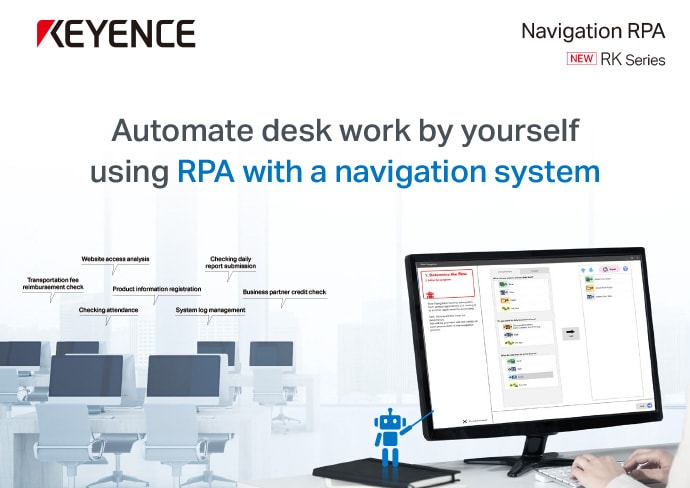Nagatanien Co., Ltd.
The intuitive, block-based approach to building automation programs is what makes RK so appealing! In just one year, our on-site staff achieved a reduction of approximately 380 hours of work!
Nagatani-en Co., Ltd. introduced KEYENCE's RPA (Automation) tool, RK, aiming to enable employees on the front lines to improve their own workflows. After just a few months of implementation, RK was adopted by around 100 employees, leading to an annual reduction of approximately 380 hours of work. We spoke in detail with Mr. Hisashi Watanabe, Head of the Product Information Department in the Quality Assurance Division of Nagatani-en Holdings, and Mr. Hiroki Wakabayashi and Ms. Eiriko Takaoka from the Production Strategy Department, about how RK is being used and its impact.
Nagatani-en Co., Ltd.
Founded in 1953, Nagatani-en is a food manufacturer committed to the corporate philosophy of "Pure Taste." While boasting long-standing hit products like "Ochazuke Nori" and "Matsutake Flavored Soup," the company focuses on developing innovative, delicious, and unparalleled products that cannot be easily duplicated. This approach, combined with high-quality products, has captured many people's hearts, leading to growth across various sectors, including household foods, commercial foods, and overseas markets.
- Established: April 1953
- Capital: $24 million
- Sales: $760.2 million (Fiscal year ending March 2023)
- Employees: 2,597 (as of the end of March 2023)
Automating Data Processing Tasks
Please tell us about the current usage of RK.
RK is mainly used within Nagatani-en and Nagatani-en Holdings for administrative data processing tasks. Examples include transferring expense data from one system to another, retrieving and processing online stock information to output as PDFs, and automating routine "mindless" tasks that require little thinking but repetitive manual effort.
Recently, we have also promoted RK adoption at Nagatani-en Foods, our manufacturing subsidiary, to improve factory operations.
The production strategy department manages about 19 automation scenarios. However, departments like Quality Assurance and the Secretary’s Office have also developed their own scenarios. As a whole around 30 scenarios have been developed and are now in production.
Since starting use about six months ago, we have two creator licenses and two runner licenses. Since the tool has several users, a schedule has been introduced to prevent usage conflict.
What we were seeking was an RPA that we could automate independently.
What prompted the adoption?
The employees on the front lines wanted a tool that they could use independently to improve their workflows. We had previously implemented several third-party RPA tools, but they were quite difficult for non-programmers to operate. This meant that automating tasks required assistance from the IT department, which involved multiple back-and-forth communications and took time.
We realized that introducing an easy-to-use RPA for frontline staff was essential. During an IT trade show, we discovered RK. After speaking with KEYENCE sales representatives, we learned that RK offers a monthly subscription that allows for trial use, and the development licenses are very affordable—so affordable that they didn't require internal approval. We decided to give it a try.
The appeal of intuitive operation led to full-scale adoption
What motivated you to move from trial to full implementation?
The main reason was how intuitive it was to operate. Building automation workflows felt like stacking blocks, and simply combining commands written in Japanese made scenario creation straightforward. Additionally, features like clicking through windows to specify folders, and the red outlines during web scraping to ensure accurate data collection, made the tool very user-friendly. The preview images of buttons within scenarios also helped confirm actions easily.
Most importantly, no programming knowledge was needed to develop scenarios. Once familiar, users can create scenarios that save about an hour of work in just a few minutes. This was exactly the "self-sufficient workflow improvement tool" we had been seeking.
Impact: 380 hours saved annually, along with improvements in work quality and process
Please tell us about the benefits of implementation.
We achieved approximately 380 hours of work reduction per year.
However, this figure only accounts for the 19 scenarios managed by the Production Strategy Department. When including scenarios developed independently by departments like Quality Assurance and the Secretary’s Office, the actual time savings are likely even greater.
Qualitative effects that can't be measured
There are four main benefits:
Workflow improvements
Automating with RK first requires organizing the workflow. During this process, we realized that some steps might be unnecessary, leading to workflow revaluation. Not only did RK automation reduce workload, but the process review itself resulted in significant additional time and energy reductions.
Increased accuracy
Manual data entry often leads to mistakes or copy-paste errors. When transferring many items, it can be hard to keep track of progress. RK performs repetitive tasks without errors, significantly improving work accuracy.
Easier handoffs
RK scenarios are written like stacked blocks of commands, making them easy to understand, even for non-developers. This has been very helpful during staff turnover, such as retirements or maternity leave, as scenarios can be easily modified without specialized skills.
Focus on higher-value tasks
Many routine tasks in the operations department are mindless manual work. RK has taken over these tasks, allowing staff to concentrate on more strategic, cognitively demanding work. For example, automating the collection of daily data means employees start their mornings with the latest data, transforming the way they work.
Over 100 users! Tips for spreading RK within the company
RK is used across many departments - What strategies helped you expand RK usage so quickly within just a few months?
Primarily, we made efforts to encourage many people to try RK. We reached out via groupware to find those interested in using RK and actively promoted participation. For those who expressed interest, we provided installers and step-by-step guides to make trial use easy and accessible. Currently, over 100 employees are using RK. We also hold quarterly "information exchange meetings" where developers share what scenarios they are working on. These sessions are recorded as videos so employees can review them anytime.
Additionally, we created an internal FAQ site to answer common questions and share lessons learned from interactions with KEYENCE. This resource has helped staff become more self-sufficient in troubleshooting, as many questions tend to be similar across users.
Evaluation of KEYENCE’s support: always helping us take the next step
How do you evaluate KEYENCE’s support system?
It’s very comprehensive. When we send inquiries via email, we receive prompt responses, making it easy to ask questions. We also appreciate that anyone can directly contact KEYENCE. Sometimes, the Production Strategy or Quality Assurance departments can’t handle certain issues alone, but we can simply ask KEYENCE directly, which is very helpful. Their support is thorough. When we faced difficulties, they quickly suggested multiple solutions or even set up online meetings to guide us while viewing our screens.
Their consistent effort to help us move forward is very reassuring.
Future challenges: developer management, scenario library, and sharing
What are your future plans?
The goal of independently improving workflows without relying on the IT department, which we initially envisioned, is gradually being realized. However, as RK becomes more popular and widely used, it’s becoming harder to keep track of who is using it and what scenarios are running. Going forward, we want to better understand the developers and scenarios, and create a scenario library to share useful automations, enabling reuse and reference.
If such an environment is established, we expect the number of RK users within the company to grow even further. We hope KEYENCE will continue providing the same level of dedicated support to help new users. We also look forward to having KEYENCE participate in our upcoming RK "information exchange meetings," and can coordinate the schedule accordingly.

Navigation RPA RK Series
View Catalog
